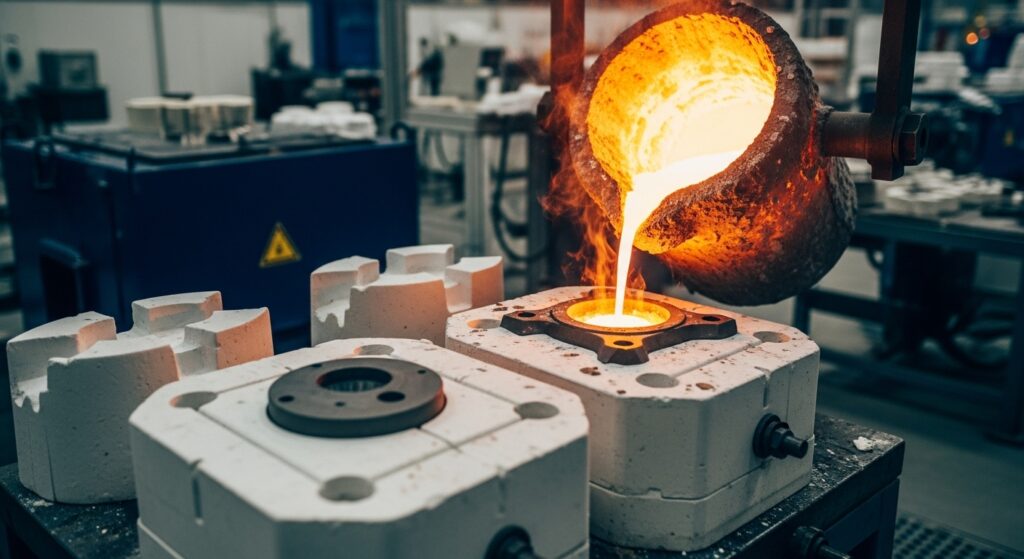The main difference between investment casting and HPDC (high-pressure die casting) is the process and part complexity. Investment casting uses wax patterns and ceramic molds to produce complex, precise shapes with excellent surface finish. HPDC injects molten metal into a steel mold under high pressure, ideal for high-volume production with simpler geometries.

Investment Casting is a metal forming process that produces parts with precise dimensions and smooth surfaces. It is particularly useful for intricate shapes and detailed parts. Often called “lost-wax casting,” this method can handle various metals, including steel, aluminum, and bronze.
Investment casting stands out due to its accuracy. The technique minimizes extra finishing, creating clean, detailed parts directly from molds. This is ideal for making items that require detailed patterns or specific designs, such as jewelry or specialized machine components.
High Pressure Die Casting (HPDC) quickly and reliably creates metal parts by forcing molten metal into molds at high pressure. It is mostly used for high-volume production, making items like automotive components and appliances.
HPDC is fast and cost-effective for large runs of products. While less precise in detail than investment casting, HPDC offers good dimensional accuracy and consistent quality, ideal for mass-produced parts that don’t need extreme detail.
| Feature | Investment Casting (IC) | High-Pressure Die Casting (HPDC) |
|---|---|---|
| Mold Material & Lifespan | Disposable ceramic shell (single use) | Reusable hardened tool steel die (100,000s to millions of cycles) |
| Tooling Cost (Initial) | Lower (for wax pattern mold) | Very High (for steel die) |
| Part Complexity (Intricacy) | Excellent for highly intricate details, complex internal geometries | Good for complex external shapes; internal complexity more limited |
| Part Complexity (Undercuts) | Readily accommodates undercuts | Undercuts are challenging and costly (require slides/side cores) |
| Part Complexity (Internal Features) | Excellent (via soluble/ceramic cores) | Limited (sand cores generally not usable) |
| Material Compatibility (Ferrous) | Yes (steels, stainless steels, etc.) | No (generally not suitable) |
| Material Compatibility (Non-Ferrous) | Yes (Al, Cu, Ni, Co, Ti alloys, etc.) | Yes (primarily Al, Zn, Mg alloys; some Cu alloys) |
| Material Compatibility (High-Temp Alloys) | Excellent (e.g., superalloys) | Limited (due to die life) |
| Typical Tolerances (25mm part) | +/- 0.250 mm (can be tighter, e.g., CT4-CT7) [1, 2] | +/- 0.050 mm (can be tighter) [2] |
| Typical Surface Finish (Ra) | 1.6 – 3.2 µm (~63-125 RMS); no parting lines [3, 1, 4] | 0.8 – 1.6 µm (~32-63 RMS); parting lines present [4, 5] |
| Production Volume Suitability | Low to Medium [6, 7, 1, 8] | High to Very High (Mass Production) [6, 7, 1, 8] |
| Cycle Time (Per Part/Shot) | Long (hours for mold prep; minutes to hours for casting/cooling) [8, 2, 9] | Very Short (seconds to minutes) [2, 10, 11, 9, 12] |
| Post-Processing Needs (General) | Minimal (gate removal, cleaning); often near-net-shape [6, 3, 1, 13] | Trimming (flash, runners, gates) essential; possible machining [6, 7, 14, 2] |
| Per-Part Cost (Low Volume) | More economical | Less economical (due to high tooling amortization) |
| Per-Part Cost (High Volume) | Less economical | More economical |
| Max Part Size/Weight (General) | Ounces up to ~150-200 lbs (68-90 kg) [2, 13] | Varies by machine; can produce large automotive parts but cost increases significantly |
| Porosity Risk | Generally low | Higher risk (gas and shrinkage porosity) if not well-controlled [2, 11, 15, 16] |
| Suitability for Heat Treatment | Generally good | Often limited due to trapped gas porosity [2] |
| Design Freedom | Very High | Moderate to High (constrained by die ejection) |
